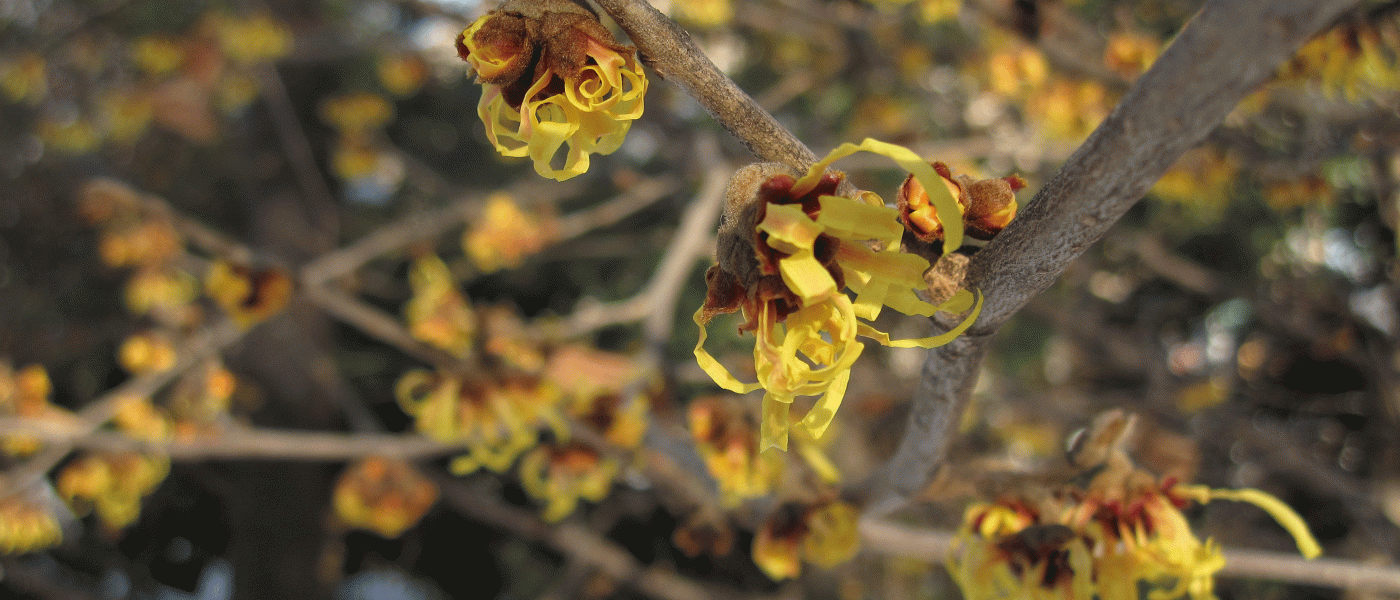Witch-Hazels: Winter Flowers, Fall Foliage, and Lovely Form
If there’s a plant that’s easier to love than witch-hazel, I have yet to encounter it. It has a lovely natural form, smooth gray bark, and soft green foliage that turns vibrant colors in the fall. It thrives in a variety of conditions and is generally pest-free. Maybe best of all, it has unusual, fragrant flowers that bloom when few other flowers do: between October and March (depending on the species, cultivar, and weather).
Witch-hazel flowers earlier than other plants and stays in bloom longer as well. Most perennial plants bloom for roughly two weeks, but witch-hazel does so for eight weeks or more. It first opens in winter, usually during a warm spell, but the flowers don’t die when the temperature drops back down. Instead, the ribbonlike petals curl up temporarily, and as soon as the temperature rises, they unfurl again.
The light, citrusy fragrance of witch-hazel flowers can be faint outdoors, especially if the weather is cold and overcast. But inside, a few cut branches in a vase of water will perfume the room and brighten your entire home during the long, dark winter.
Witch-hazels are described as small trees or large shrubs, and the various species and cultivars of the Hamamelis genus can range from 5 to 20 feet tall and are often just as wide. Grow witch-hazel alone as a specimen plant or in groups under a deciduous canopy along with early-spring bulbs and perennials. It does well planted amid a carpet of spring flowers like Crocus, Galanthus, Muscari, and Erythronium. Wherever you decide to grow it, witch-hazel is a worthy addition to the garden.
Cultivating Witch-Hazels
Although an understory shrub in the wild, witch-hazel adapts to many different garden conditions. It tolerates sun, drought, and wind as well as various soil types, but it thrives best in light shade in well-drained, moist soils and with some protection from the elements.
Plant witch-hazel in the early spring or late fall. After planting, provide supplemental water if rainfall is less than an inch per week or in exceptionally hot, dry weather. Once your witch-hazel is established in your garden, it will not need additional watering except during severe drought or unless it’s planted in full sun.
As long as you site Hamamelis species with their mature size in mind, you will have little pruning to do. If you see suckers (vertical shoots at the base of your plant), remove them after leaf drop in the fall—if you prune them during the growing season, you run the risk of stimulating more sucker growth. As with all shrubs and trees, remove any dead or damaged branches as soon as you notice them. If your witch-hazel is in danger of outgrowing its location, prune to limit size annually after flowering but before the leaves emerge. Simply trim back the previous year’s growth to a few leaf buds per branch. At the same time of year, remove any crossing or rubbing branches and maintain the naturally horizontal habit of the plant by removing branches growing sharply vertically.
Species and Cultivars
Ozark Witch-Hazel
Hamamelis vernalis
Native to the southern and central United States, Hamamelis vernalis is one of the earliest and longest-blooming witch-hazels. Its red to yellow flowers bloom from January into April, depending on the weather. It has yellow fall foliage that persists on the branches late into the season.
Ozark witch-hazel grows about 10 feet tall and up to 15 feet wide. In the wild, it spreads by underground runners (stolons) to form colonies, but this can be kept in check by regular pruning of the runners and suckers. Hamamelis vernalis is uncommon in American gardens, but that’s changing as demand for native plants grows. There are also cultivars of this species available, including some purple-flowered ones like ‘Amethyst’ and ‘Purple Prince’.
Common Witch-Hazel
Hamamelis virginiana
Hamamelis virginiana bark has an extensive history of medicinal use, and the astringent commercially available as witch-hazel is still made from this plant. Unlike many other witch-hazels, this species usually blooms early, in October. Since this may be before leaf drop, sometimes the blooms are hidden by the leaves. The cultivar ‘Harvest Moon’ flowers after leaf drop, so the overall effect is showier. H. virginiana is one of the larger witch-hazels, at 20 feet tall and wide, but ‘Little Susie’ grows to only 5 feet tall and wide.
Chinese Witch-Hazel
Hamamelis mollis
This species’ yellow flowers from January to March and yellow foliage in the fall add lightness to the landscape. It is slightly more upright and rounded than some other witch-hazels and will spread to 15 feet wide in time, so plant Hamamelis mollis in a location where it will have room to grow. One standout cultivar is ‘Wisley Supreme’, which is smaller than the straight species, with large, fragrant, golden-yellow flowers tightly clustered on the stems. Examples can be seen at Brooklyn Botanic Garden in the Discovery Garden and the Plant Family Collection.
Japanese Witch-Hazel
Hamamelis japonica
Native to Japan, the yellow-flowered Hamamelis japonica grows 10 to 15 feet tall and wide. When planted in heavy shade (as it is in the Rock Garden) it will become looser and spread out to catch the sun. Though the straight species needs a lot of space to grow, there is a compact, weeping cultivar called ‘Pendula’ that grows to 8 feet tall by 6 feet wide.
Hybrid Witch-Hazel
Hamamelis × intermedia
A cross between Hamamelis mollis and H. japonica, this is the witch-hazel you are most likely to find in a nursery. Most hybrid cultivars grow 8 to 12 feet tall and bloom from January to March, including ‘Diane’, which has rich red flowers, and ‘Pallida’, a light-yellow-flowered option. My favorite is ‘Jelena’, which has spectacular fall foliage, fragrant, multicolored flowers ranging from orange to dark copper, and a beautiful natural vase-shaped form. The specimen in the Rock Garden is particularly wonderful.


